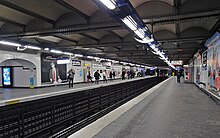Réaumur - Sébastopol (Métro Paris)
|
|
|
|---|---|

|
|
| Tariff zone | 1 |
| Line (s) |
|
| place | Paris II , III |
| opening | November 19, 1904 |

Réaumur - Sébastopol is an underground transfer station of the Paris Métro . It is served by lines 3 and 4 .
location
The metro station is located on the border of the Quartier de Bonne-Nouvelle in the 2nd arrondissement with the Quartier des Arts-et-Métiers in the 3rd arrondissement of Paris .
The station of line 3 is longitudinally below the Rue Réaumur west of its intersection with the Boulevard de Sébastopol, that of the line 4 along below the Boulevard de Sébastopol north of the intersection.
Surname
It is named after the Rue Réaumur and the Boulevard de Sébastopol. René-Antoine Ferchault de Réaumur (1683–1757) was a polymath who u. a. invented the alcohol thermometer . In this context, he developed the Réaumur temperature scale , which was in use in Europe until the beginning of the 20th century.
Sébastopol (dt .: Sevastopol ) is a port city on the peninsula of Crimea in the Black Sea . After a year-long siege and heavy fighting, it was stormed by French-English troops in September 1855.
Initially, the station after the nearby street of the same name was put into operation under the name "Rue Saint-Denis", the name change took place on October 15, 1907. The city of Saint-Denis borders Paris immediately to the north, at the time of the construction of Metro line 3 it had about 60,000 inhabitants.
history
The station on line 3 went into operation on November 19, 1904, when the first section from Villiers to Père Lachaise was opened. On April 21, 1908, the first section of line 4 from Porte de Clignancourt to Châtelet , and thus its Réaumur - Sébastopol station, was opened to traffic.
description
Both stations have two side platforms on two main tracks. The station on line 3 has an elliptical cross-section, the ceiling and walls are tiled. It has the standard Paris length of 75 m.
The higher station on Line 4, which was built using the open construction method, has a horizontal metal ceiling. Longitudinal girders, which carry small vaults made of bricks, rest on iron support beams that are perpendicular to the direction of travel. In the mid-1960s, it was extended from 75 m to 90 m.
Directly in front of the stations, the routes cross at the intersection of Boulevard de Sébastopol / Rue Réaumur, with line 3 crossing under line 4. Shortly before that, both lines have a simple track change each .
The subway station has four entrances, two of which are in Rue Réaumur, one in Rue de Palestro and one in Square Émile Chautemps. They were designed by Hector Guimard .
vehicles
As a result of the accident at Couronnes station , line 3 was equipped with vehicles that ran on bogies from the start . The five-car trains consisted of three multiple units and two trailer cars . They were later replaced by Sprague-Thomson trains , which ran there until 1967. In that year, Line 3 was the first to receive the new MF 67 series , which runs classically on steel rails . These trains will still be in use there in 2020, and from 2028 they are to be replaced by trains from the MF 19 series.
Five-car trains of the Sprague-Thomson design ran on Line 4 until 1967. After the corresponding reconstruction of the route and the extension of the stations, rubber-tire six-car trains of the MP 59 series were used from October 1966 , during the first few months in mixed traffic with conventional vehicles. The MP 89 CC series has been running on the line since 2011 .
Surroundings
A short distance away is the Musée des arts et métiers with the original Foucault pendulum .
Remarks
- ↑ CC means "Conduite Conducteur" (driver-controlled), in contrast to the driverless type MP 89 CA
literature
- Gérard Roland: Stations de métro. D'Abbesses à Wagram . 2003, ISBN 2-86253-307-6 .
Web links
Individual evidence
- ^ Gérard Roland: Stations de métro d'Abbesses à Wagram . Christine Bonneton, Clermont-Ferrand 2011, ISBN 978-2-86253-382-7 , pp. 183 .
- ^ Jean Tricoire: Un siècle de métro en 14 lignes. De Bienvenüe à Météor . 2nd Edition. La Vie du Rail, Paris 2000, ISBN 2-902808-87-9 , p. 165 .
- ↑ Jean Tricoire: op. Cit. P. 183.
- ^ Brian Hardy: Paris Metro Handbook . 3. Edition. Capital Transport Publishing, Harrow Weald 1999, ISBN 1-85414-212-7 , pp. 36 .
- ↑ Jean Tricoire, op. Cit. P. 86.
- ↑ Jean Tricoire, op. Cit. P. 165.
- ↑ Jean Tricoire, op. Cit. P. 168.
- ↑ Jean-Gabriel Bontinck: Métro: ligne par ligne, découvrez quand les nouvelles arriveront rames. In: Le Parisien . April 11, 2019, accessed on June 7, 2020 (Fri-FR).
| Previous station | Paris metro | Next station |
|---|---|---|
|
Sentier ← Pont de Levallois - Bécon |
|
Arts et Métiers Gallieni → |
|
Strasbourg - Saint-Denis ← Porte de Clignancourt |
|
Étienne Marcel Mairie de Montrouge → |
Coordinates: 48 ° 51 '58.5 " N , 2 ° 21' 8.6" E

